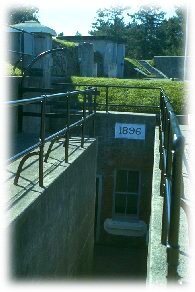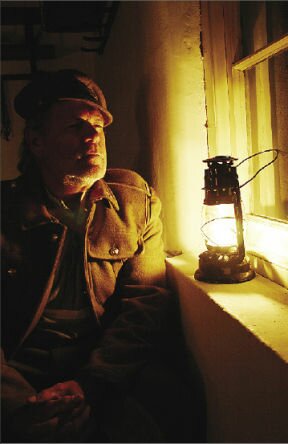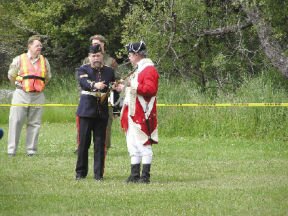Fort Rodd Hill – a National Historic Site

is a coast artillery fort built in the late 1890s to defend Victoria and the Esquimalt Naval Base. The Fort includes three gun batteries, underground magazines, command posts, guardhouses, barracks and searchlight emplacements. There are numerous interpretive signs and audio-visual stations, as well as period furnished rooms and friendly, knowledgeable staff. Visitors can explore gun batteries and underground magazines built a century ago, as well as searchlight emplacements, command posts…and much more.
At Fort Rodd Hill, visitors can explore gun batteries and underground magazines built a century ago, as well as searchlight emplacements, command posts…and much more. Signs, audio and video stations, and friendly, knowledgeable staff tell the stories of this national historic site.
Families often bring a picnic lunch and stay for a half a day. While the kids investigate our tide pools, parents can enjoy the spectacular sea and mountain views. Come visit soon!

fort rodd by lantern light Historic re-enactor Larry Emrick peers out of his recreated Second World War bunk house during lantern tours at Fort Rodd Hill National Historic Site. Photo Credit Goldstream Gazette
Photography
The waterfront sites at Fort Rodd Hill and Fisgard Lighthouse are extremely photogenic, especially with the scenic backdrop of the Olympic Mountains in neighbouring Washington state.
The Strait of Juan de Fuca almost always offers a wide variety of ships, from small sailing vessels, to enormous cargo ships, and the proximity of the Canadian Navy base means that military craft of several nations are often seen at close range.
Wildlife at the sites includes Columbian black-tailed deer, river otters, mink, raccoons, harbour seals, and sea lions.
Bird-watching
Birders may be rewarded with a wide variety of both pelagic and meadow birds, including bald eagles, blue herons, harlequin and eider ducks, and many small songbirds.
Scuba Diving
Scuba diving is becoming more and more popular in the waters around Fisgard Lighthouse, but divers are advised that there is no vehicle access and that they will have to transport their equipment about 500 metres (1/4 mile) from the parking lot. (Hint: bring a wheelbarrow to move tanks and weights!)
Picnicking
There are 12 picnic tables, including one for disabled visitors, near the parking lot. You may also picnic inside the sites, under the trees on the main field, or on any of our three beaches. Please note that there are no fires or barbeques permitted in the sites.
Food Service
The Fort Rodd Hill and Fisgard Lighthouse Preservation Society offers light refreshments and souvenirs in the old Canteen building inside Fort Rodd Hill during the summer months.

British bid adieu a century ago
By Rick Stiebel
Goldstream News Gazette
May 17 2006
A century ago today, soldiers stationed to defend Esquimalt Harbour were rousted early from their hard iron beds and began the long journey back to Britain.
The May 17, 1906 departure of the Royal Engineers and the Royal Garrison Artillery signalled the end of an era – they were the last British troops stationed in Canada.
More than 300 strong, the troops had been stationed at Fort Rodd Hill, Esquimalt and along the coast to protect Esquimalt Harbour from naval attacks.
Their arrival in 1893 had marked the beginning of a new agreement between Canada and Britain to share the cost of building modern, permanent artillery batteries, said Dale Mumford, community relations officer at Fort Rodd Hill and Fisgard Lighthouse National Historic Site.
Construction on the new batteries began at Fort Rodd Hill in 1895, and the new, six-inch breech-loading artillery guns were first tested by the Royal Marine Artillery in October of 1897.
Once they were in place, work began on three additional batteries designed to mount smaller, quick-firing guns to defend against attack by torpedo boats, in response to Britain’s perception of the threat of war with Russia.
The Royal Garrison Artillery manned the batteries, while the Royal Engineers were responsible for installing searchlights and an underwater mine field across the mouth of Esquimalt Harbour.
In 1905, however, the British Pacific Squadron was disbanded as part of a major reorganization. The Royal Navy had decided to concentrate more warships in British waters in response to the growth of the Imperial German navy, Mumford explained.
“The arms race leading to World War I had begun,” said Mumford, who earned a bachelor degree in history from the University of Victoria in 1979. “The Esquimalt naval base was mothballed, with only three old naval sloops left here to perform surveying and policing duties on the West Coast.”

Parks Canada/Brys Stafford
Verlyn Busch, right, in 1790’s Royal Marine Uniform and Dale Mumford in 1890’s Royal Marine Artillery uniform demonstrating the Brown Bess flintlock musket, at Fort Rodd Hill
The departure of the garrison may have ended the story of the British army’s role in the defence of Canada, but it left behind a lasting legacy, Mumford said.
More than 60 members of the Royal Garrison Artillery and Royal Engineers stayed behind and accepted the opportunity to transfer to the Canadian Permanent Force.
They formed the nucleus of two new Canadian units that maintained the fortifications at Fort Rodd Hill, the 5th Heavy Company, Royal Canadian Garrison Artillery and 3 (Fortress) Company, Royal Canadian Engineers.
“A lot of these folks fell in love with the area,” said Mumford, a self-described navy brat who got hooked on military history while working at Fort Rodd Hill during the summers of his university days. “Some of them had married locals or had ties to the community.”
There are still local residents who can trace their family back to soldiers that remained, Mumford said.
“There’s not a week that goes by where I don’t learn something new,” he said.
According to a recruiting poster from the era, staff sergeants topped the pay scale at $1 a day, sergeants earned 80 cents, corporals 70 cents and bombardiers 50 cents, while buglers under 18 years of age and gunners started at 40 cents a day.
Free rations consisted of a pound each of bread, meat and potatoes, an ounce of pot barley, an ounce of coffee and a halfpence of tea, two ounces of sugar, and a halfpence each of salt and pepper that the cooks doled out in the standard three squares a day.
Recruits also received a cloth tunic, serge, forage cap, winter cap, a pair of trousers, boots and mitts.
The companies remained active until 1956, when coast artillery was declared obsolete because of the advance of jet air craft, long-range carriers and intercontinental bombers, Mumford explained.
With files from Dale Mumford
The site will also open a small, temporary exhibit on May 26 featuring some never-before-seen artifacts and photographs of the British Garrison at Esquimalt.
The exhibit will be on display in the Warrant Officer’s Quarters on the site until October 1.
Admission to the Historic military Encampment is at the regular site price of $4 for adults, $3.50 for seniors and $2 for youths aged six to 16, with children under six admitted for free when accompanied by an adult.
Fort Rodd Hill, off of Ocean Boulevard in Colwood, is open from 10 a.m. to 5 p.m.
Please be advised that no pets are allowed on site. For more information, call 478-5849
© Copyright 2006 Goldstream News Gazette
